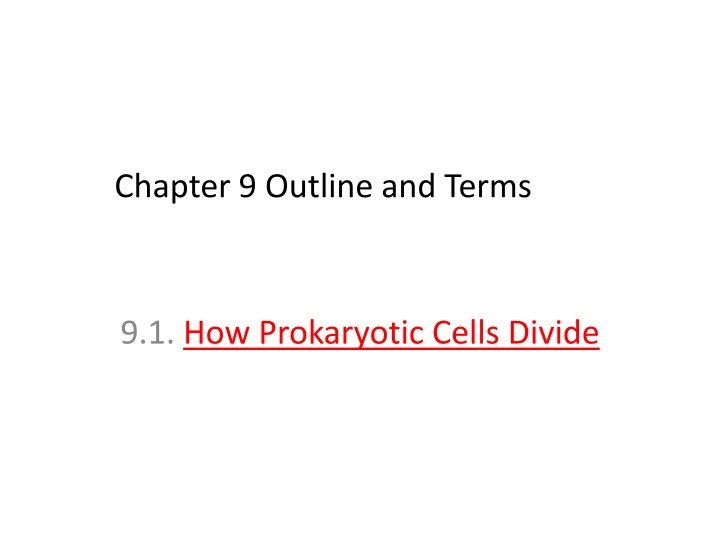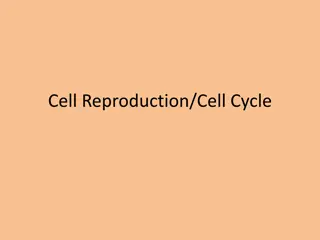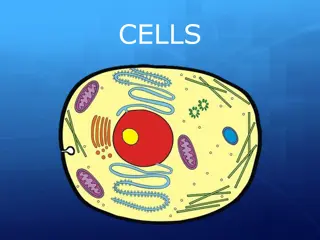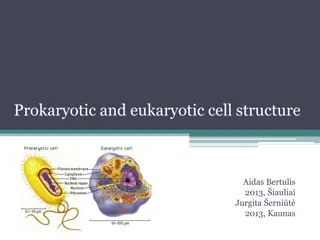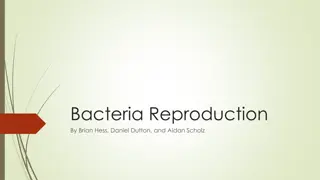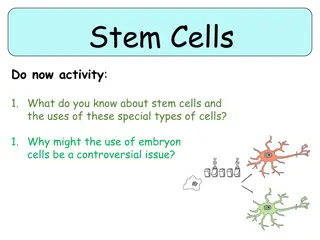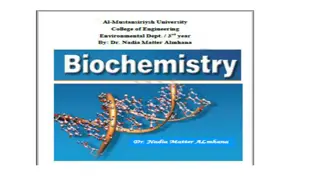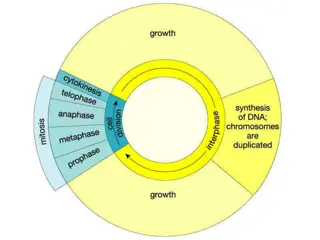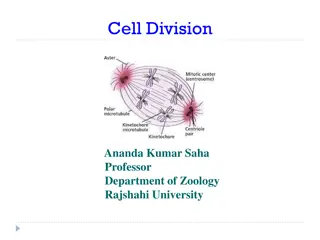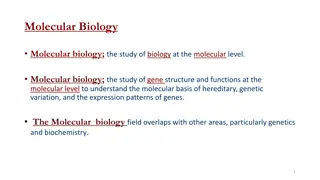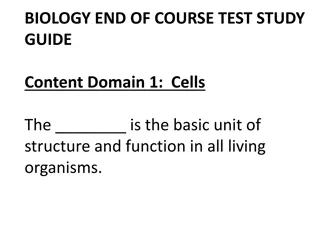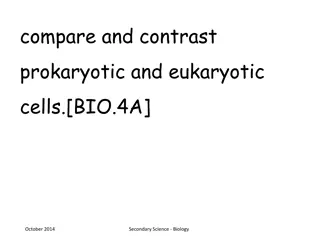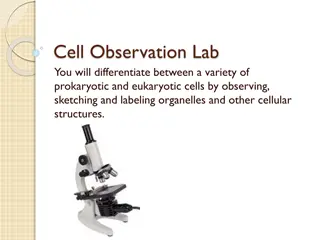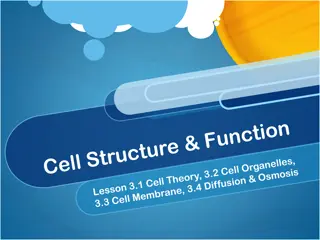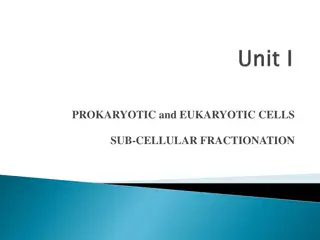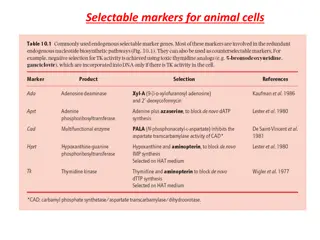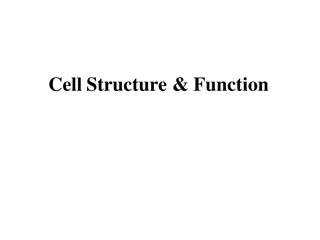Cell Division Mechanisms in Prokaryotic and Eukaryotic Cells
Prokaryotic cells divide through binary fission, while eukaryotic cells undergo mitosis with nuclear division and cytokinesis. Prokaryotic cells lack a nucleus and divide by replicating DNA and forming two identical daughter cells. Eukaryotic chromosomes, associated with histone proteins, undergo coiling during cell division, maintaining chromosome number. The differences in chromosome organization and cell division mechanisms between prokaryotic and eukaryotic cells highlight the unique characteristics of each cell type.
Uploaded on Sep 24, 2024 | 1 Views
Download Presentation

Please find below an Image/Link to download the presentation.
The content on the website is provided AS IS for your information and personal use only. It may not be sold, licensed, or shared on other websites without obtaining consent from the author.If you encounter any issues during the download, it is possible that the publisher has removed the file from their server.
You are allowed to download the files provided on this website for personal or commercial use, subject to the condition that they are used lawfully. All files are the property of their respective owners.
The content on the website is provided AS IS for your information and personal use only. It may not be sold, licensed, or shared on other websites without obtaining consent from the author.
E N D
Presentation Transcript
Chapter 9 Outline and Terms 9.1. How Prokaryotic Cells Divide
A. Prokaryotic cells lack a nucleus and other membranous organelles; include only the bacteria. B. The Chromosome Is Singular 1. Prokaryotic chromosome contains mostly DNA and some associated proteins, but much less protein than eukaryotic chromosomes. 2. Single prokaryotic chromosome is tightly coiled inside the cell. 3. Chromosome consists of nucleoid---an irregularly- shaped region, electron dense, and not enclosed by a membrane. 4. Chromosome, when stretched out, is a circular loop attached to the inside of the plasma membrane; about 1,000 times the length of the cell
C. Division is by Fission . 1. Asexual reproduction requires a single parent; offspring are genetically identical to parent. 2. Binary fission of prokaryotic cells produces two genetically identical daughter cells by division (fission). 3. Before cell division takes place, DNA is replicated so two chromosomes are attached inside the plasma membrane. 4. Following DNA replication, the two chromosomes separate when cell lengthens and pulls them apart. 5. When cell is approximately twice its original length, the plasma membrane grows inward, a new cell wall forms, dividing the cell into two approximately equal daughter cells. 6. Generation times of Escherichia coli is 20 minutes; most bacteria need one hour to a day.
9.2. Eukaryotic Chromosomes and the Cell Cycle : A. Chromosomes : 1. DNA in the chromosomes of eukaryotic cells is associated with proteins; histone proteins organize chromosomes. 2. When a Eukaryotic cell is not undergoing division, DNA within a nucleus is a tangled mass of threads called chromatin. 3. At cell division, chromatin becomes highly coiled and condensed and visible as chromosomes. 4. Each species has a characteristic number of chromosomes. : a. Diploid (2n) number includes two sets of chromosomes of each type. Found in all the non sex cells of an organism's body (with a few exceptions). Examples include humans (46), crayfish (200), etc. b. Haploid (n) number contains one of each kind of chromosome. In the life cycle of many animals, sperm and egg cells have the haploid number. Examples : humans (23), crayfish (100), etc.
5. Cell division in Eukaryotes involves nuclear division and cytokinesis (division of the cytoplasm). a. Somatic (body) cells undergo mitosis involved in the development, growth, and repair of multicellular organisms. 1) This nuclear division leaves the chromosome number constant. 2) A 2n nucleus divides to provide daughter nuclei that are also 2n. b. A chromosome begins cell division with two sister chromatids. . 1) Sister chromatids are two parts of a chromosome, at the beginning of cell division, that are attached at a centromere; each consists of a DNA molecule identical to the DNA molecule of the other chromatid. 2) Centromere---a region of constriction on a chromosome, where sister chromatids are attached.
9.3. How Eukaryotic Cells Divide : A. In mitosis, a spindle assists orderly distribution of chromosomes to daughter cell nuclei; chromosome number stays constant. 1. The spindle contains many fibers, each composed of a bundle of microtubules. 2. Microtubules are made of the protein tubulin, assemble when tubulin subunits join, disassemble when tubulin subunits become free, and form interconnected filaments of cytoskeleton; disassemble as spindle fibers form. 3. Centrosomes are believed responsible for organizing spindle. a. centrosome is the main microtubule organizing center of the cell. b. The centrosome has divided before mitosis begins. c. Each centrosome contains a pair of barrel-shaped organelles called centrioles; plant cells lack centrioles.
B. How Animal Cells Divide : Mitosis (karyokinesis) is divided into five phases: prophase, prometaphase, metaphase, anaphase, and telophase. :- 1- Prophase: a. Nuclear division is about to occur because chromatin condenses and chromosomes become visible. b. The nucleolus disappears and the nuclear envelopefragments. c. Already duplicated chromosomes are composed of two sister chromatids held together by a centromere. 1- This configuration in diagrammatic drawings gives accurate chromosome number. 2- Chromosomes have no particular orientation in cell at this time. 3- Specialized protein complexes (kinetochores) develop on each side of centromere for future chromosome orientation. d. Spindle begins to assemble as pairs of centrosomes migrate away from each other. e. Short microtubules radiate out from the pair of centrioles located in each centrosome; form starlike asters.
2. Prometaphase [not depicted] : a. At this time, the spindle consists of poles, asters, and fibers that are bundles of microtubules. b. Important event during prometaphase is attachment of chromosomes to the spindle and their movement as they align at the metaphase plate (equator) of the spindle. c. The kinetochores of sister chromatids capture kinetochore spindle fibers. d. The chromosomes move back and forth until they are aligned at the metaphase plate. 3. Metaphase : a. Chromosomes, attached to kinetochore fibers, are aligned at the metaphase plate. b. Nonattached spindle fibers, called polar spindle fibers, can reach beyond the metaphase plate and overlap. 4. Anaphase : a. Two sister chromatids of each duplicated chromosome separate at centromere. b. Daughter chromosomes, each with a centromere and single chromatid, move to opposite poles. 1- Polar spindle fibers lengthen as they slide past each other. 2- Kinetochore spindle fibers disassemble at the kinetochores; this pulls daughter chromosomes to poles. 5. Telophase : a. Spindle disappears. b. Chromosomes de condense and return to chromatin; the nuclear envelope reforms and nucleoli reappear. c. Cytokinesis is nearly complete.
In Animal Cells : a. Cleavage furrow indents the plasma membrane between the two daughter nuclei at a midpoint; progressively divides cytoplasm during cell division. b. Cytoplasmic cleavage begins as anaphase draws to a close. c. Cleavage furrow deepens as band of actin filaments slowly constricts between the two daughter cells. d. Narrow bridge exists between daughter cells during telophase; then constriction separates the cytoplasm. Cell Division and Cytokinesis in Other Organisms: a. Protists and fungi also undergo mitosis and cytokinesis. b. In fungi and some protists, the nuclear envelope does not fragment but divides and one nucleus goes to each daughter cell.
9.4. Comparing Prokaryotes and Eukaryotes: A. Functions: 1. Binary fission and mitosis both ensure each daughter cell is genetically identical to the parent cell. 2. Cell division in unicellular organisms accomplishes asexual reproduction. 3. Cell division in multicellular organisms accomplishes development, growth, and repair of multicellular organism .
B.Prokaryotes differ because of the following: 1. The single chromosome consists largely of DNA with some associated proteins. 2. Cell elongation separates the anchored DNA strands and a new cell wall forms between daughter cells. 3. No spindle apparatus is involved in binary fission. C. Eukaryotes differ because of the following: 1. protein histone organizes a chromosome, allowing extension to chromatin and coiling for mitosis. 2. species vary with a characteristic number of chromosomes. 3. a spindle appears and helps distribute daughter chromosomes to daughter nuclei. 4. cytokinesis involves formation of a cell plate in plants or furrowing in animal cells.
Prophase Metaphase Anaphase Telophase Four Mitotic Stages 13
Thank you for listening Thank you for listening
